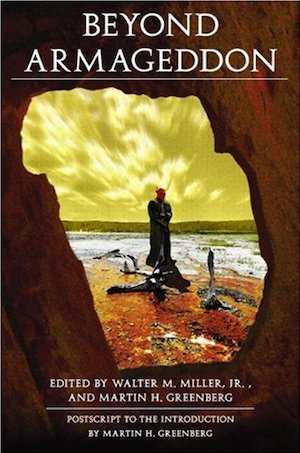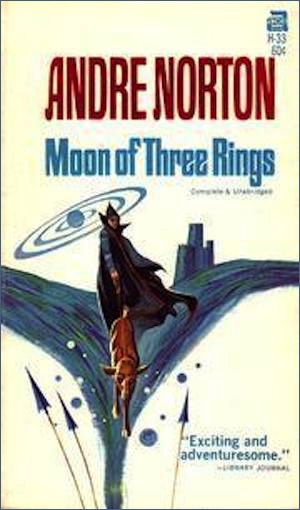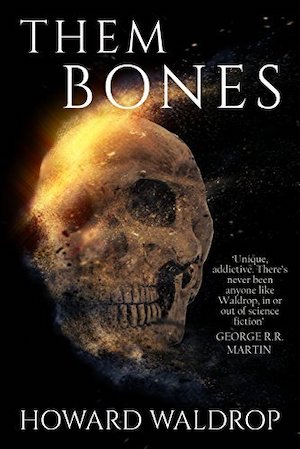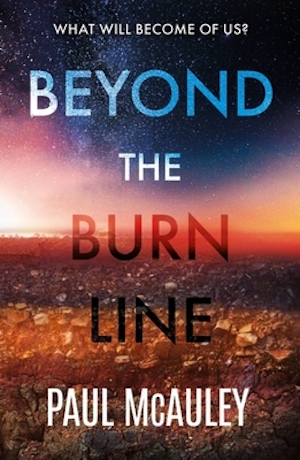One of the rewards of travel and tourism is the opportunity to admire ruins of great antiquity. Across the planet, edifices remain to attest to the achievements of past civilizations now lost to history. Indeed, many of these sites are so impressive that a person could be forgiven for looking around at modern, well-maintained, and occupied buildings to ponder how they might best be converted into relics along the lines of the Roman Forum, Harappa, and Chichén Itzá.
The three most important ingredients? Time, bad luck, and poor judgement.
“The Music Master of Babylon” by Edgar Pangborn (1954)
Collected in Beyond Armageddon (1986)

Having advanced to the point of launching not one but two interstellar missions (fates unknown), the civilizations of the world then proceeded to comprehensively mismanage climate change while edging ever closer to the Final War. That Final War came in 2070, freeing the vast majority of humanity from their daily woes.
Brian Van Anda has lived for a quarter century in the Museum of Man, in a decaying Manhattan isolated by ocean rise and depopulated by nerve gas but otherwise spared the more violent weapons that scoured less fortunate communities. Now after a quarter century, visitors have come calling. What will the savage children of tomorrow make of a relic of a civilization about whose existence they never learned?
Pangborn fans might recognize this as a rough draft of what later became Pangborn’s Darkening World. One might see this as a retelling of Benet’s “By the Waters of Babylon,” told from the perspective of someone who still remembers the civilization responsible for the ruins. The story’s treatment of climate change may seem odd to modern eyes: despite the clear and present threat presented by melting icecaps, humans spent the 21st century kidding themselves that “the flood years have passed their peak and a return to normal is expected.” Where do SF authors get their crazy ideas?
A new normal does seem to be firmly established by the end of the novel, so perhaps the Panglossian pundits were correct after all (in a way).
Moon of Three Rings by Andre Norton (1966)

To Free Trader eyes, Yiktor is a familiar sort of world. Like so many other planets, Yiktor was once home to an advanced civilization. Like so many other planets, that once-great civilization has been reduced to ruins occupied by barbarians, with the occasional treasure waiting to be uncovered by diligent visitors. Easy money!
Experience misleads the Free Traders. Other civilizations fell. Yiktor’s society was battered, but (all evidence to the contrary) was not extinguished. It was transformed. The nomadic Thassa are not the primitives the Free Traders believe. While the Thassa may have put city-building behind them, they turned to arcane technology for which the overconfident Free Traders are unprepared.
In the Free Traders’ defense, “the great civilization became decadent and self-destructed” is a pretty good bet in most Norton narratives. Andre Norton didn’t have much faith in the longevity of technological civilizations. Planets that appear healthy in one novel could be ruins when Norton revisited them centuries later. In this specific case, however, the Thassa manage to find a way out of the cycle of rise and fall.
Hope by Klaatu (1977)
As one might expect from the title of progressive rock band Klaatu’s concept album Hope, the musical narrative begins on an upbeat note, extoling the virtues of exploration. Two tracks later, the invention of a stupendously fast star drive is revealed in “Around the Universe in Eighty Days.” What wonders await our optimistic explorers?
Among them, a space-based lighthouse warning unwary starships of the scattered remnants of a shattered world. Living within, its keeper—the only remaining member of his once highly advanced species. Presumably mistakes were made. If the narrative is to be believed, mistakes will be made again, despite which the lyrics for some reason encourage listeners to embrace hope rather than the far more prudent option of profound concern about where history is taking us all.
Klaatu (comprised of John Woloschuk, Dee Long, and Terry Draper) is a Canadian band, the product of an interesting period in Canadian entertainment history. Rather than resign themselves to cultural domination by the larger US, the Canadian government of the day instituted Canadian content regulations to encourage Canadian culture. This effort was to a surprising degree successful, at least for a time. Perhaps hope is sometimes not pathological.
Them Bones by Howard Waldrop (1984)

The good news is that in 2002, the nuclear weapons into which the great powers invested so much money proved that they were not a boondoggle. The ensuing thermonuclear exchange was every bit the apocalypse which its architects expected. The single drawback, a very minor one, is that only a few people survived it and all the evidence suggests their survival will prove short-lived.
Not to worry! Time travel provides access to a pre-apocalyptic, pre-Columbian Exchange past and with it, salvation. Perhaps. More likely, however, would-be colonizers from the future will bring with them the seeds of a non-nuclear but equally horrific calamity, dooming the innocent past almost as thoroughly as they did the future.
Many writers of the long ago treated American Indians as a typographical error on the page on which American history was intended to be inscribed. Waldrop rejects this approach. Not that this means the cultures who encounter the time travellers will survive the meeting, but a sense of what will be lost is effectively conveyed.
Beyond the Burn Line by Paul McAuley (2022)

Human achievements in global transformation will be preserved as the eponymous Burn Line for as long as the geological record in which our final errors were recorded survives. Despite our best efforts to streamline the Earth’s ecosystems, complex life not only survived but flourished. Within a mere six hundred thousand years, intelligent bears dominated the Earth. When they fell in their turn, intelligent raccoons took the bears’ place.
Among human achievements independently recreated by the raccoons: academia. Pilgrim Saltmire is an ambitious scholar who hopes to complete his late master’s research into mysterious entities nicknamed the Visitors. Life is often cruel. Pilgrim’s path to enlightenment will be a very convoluted journey, at the end of which wait answers Pilgrim would have been happier not knowing.
Less than six hundred thousand years from planetary apocalypse to successor civilizations is pretty good. Also, while the bears seem to have been a rather unpleasant lot, the raccoons are the sort of people about whom one would like to read more stories. Sadly, I think this is a standalone.
***
Humans have been speculating about the fall of civilization for a very long time. It would not surprise me to find some doleful narrative about the days to come depicted in a Çatalhöyük mural. Five examples cannot hope to cover the whole of the field. Feel to mention your favourites in comments, which are as ever, below.
In the words of fanfiction author Musty181, four-time Hugo finalist, prolific book reviewer, and perennial Darwin Award nominee James Davis Nicoll “looks like a default mii with glasses.” His work has appeared in Interzone, Publishers Weekly and Romantic Times as well as on his own websites, James Nicoll Reviews (where he is assisted by editor Karen Lofstrom and web person Adrienne L. Travis) and the 2021 and 2022 Aurora Award finalist Young People Read Old SFF (where he is assisted by web person Adrienne L. Travis). His Patreon can be found here.











I just finished Beyond the Burn Line (SPOILERS) and was underwhelmed. I think my main point of contention was how…human, and how contemporary, the raccoons seemed to be. In terms of technology and language- especially for a society so far ahead in time from our own- the evolved animals didn’t feel all that strange or compelling; they felt like tiny, modern humans with all the same foibles, navigating all the same basic interpersonal and societal conflicts so I was left to wonder, what was the point? It’s a neat idea that evolved animals succeeded humanity but it was all pretty rote by the end, a curious conceit left undeveloped, even unnecessary. I wonder how different this story would have been if all the characters were simply written as humans. Not much, I suspect.
One of my favourite genres, really, but my contribution in this post will be to recommend — very highly — a factual take, in the form of the brilliant Fall of Civilisations podcast by Paul M M Cooper. Sixteen long episodes, each dealing with the history, decline, and ultimate collapse of a different society, ranging (so far) from Roman Britain to the Bagan Empire of Myanmar. Fabulous.
On the fictional side, there are so very many to choose from. Certainly Heinlein’s Orphans of the Sky must qualify, as the civilisation of the Ark has certainly collapsed into barbarism. This is probably true of most interstellar ark stories, including The Starlost (another Canadian classic, to be sure).
Star Trek‘s episode ‘The Omega Glory’ surely fits the bill.
A Canticle for Leibowitz manages it several times in one book.
And I can’t stop without mentioning one of the true classics:-
I remember a short story where aliens followed the directions on the Voyager Record back to Earth and were excavating the remains of a dam in the western US.
And AC Clarke had Venusians trying to figure out human society from a Disney cartoon
Well, I guess I can, since the web page won’t let me perform an edit for some reason. Anyway, it was meant to be a link to the IMDB site for Planet of the Apes (1968 version, of course).
Martha Wells’s City of Bones centers on artifacts from an ancient civilization in the postapocalyptic desert city of Charisat. Many of the relics are valuable, which is why the main character and his partner search for and sell them. Some are extremely dangerous.
Wells’s Raksura books (beginning with The Cloud Roads) also have lots of ruins and relics from older civilizations, but they aren’t at all the key to the story, just vivid and fascinating background.
@4 Planet of the Apes (1968 version, yes) also came immediately to my mind.
Among written works, pretty much every Conan story by Robert E. Howard?
Revelation Space by Alastair Reynolds is concerned with a fallen civilisation and the secret hidden in its solar system. Likewise, his Revenger has pirates rummaging through the bits of a collapsed interplanetary civilisation.
I’d throw in Ken MacLeod’s Newton’s Wake: A Space Opera, in which the survivors of the Hard Rapture are running through the wormholes left by the AIs and Post Humans.
If we’re including old SF films, how about “Forbidden Planet”?
Both Andre Norton’s science fiction and fantasy are ripe with failed civilizations, particularly those underground. It’s one of her fixed obsessions. It’s hard to think of a book that didn’t have ruins of another race.
See also Dark Earth by Rebecca Stott. Set in 6th Century Britain, two sisters escaping enslavement by a local warlord find a hidden society of women living in the otherwise deserted ruins of the once-great Roman city of Londinium. It is fascinating how just 100 years later, the now-vanished Romans and their accomplishments have become semi-legendary among the British people, the subject of tall tales and superstitions.
Nnedi Okorafor’s “Binti” stories come to mind. Advanced technology in an apparently-primitive area.
As I recall Binti, there wasn’t a crash. The African cultures had been in contact with Galactics for quite a while but had not bothered to mention this fact to outsiders.
Jack McDevitt’s Eternity Road is my fav of this genre. Adrian Tchaikovsky Children of Time (and Elder Race), Peter Hamilton’s Salvation and David Weber’s Off Armageddon Reef all sorta go there.
Little Black Rule: Traveller is replete with ruined civilizations, most dramatically the Ancients who had their Final War 300,000 years ago, but also when the Rule of Man gave way to the Long Night, lots of inhabited but not shirtsleeve worlds experienced a marked population shortfall.
In at least some sense, Dhalgren fits this mold…
The “Mageworlds” series by Debra Doyle and James McDonald comes to mind
Of course A Canticle for Liebowitz; I note that the Pangborn is collected in an anthology edited by Walter M. Miller Jr.
Sterling Lanier’s Hiero’s Journey and The Unforsaken Hiero are set in a post-apocalyptic North America, five millennia after what was probably a nuclear holocaust.
Joe Abercrombie’s Shattered Sea trilogy takes place in a post-apocalyptic Scandinavia, where the ruins of our contemporary cities are known as “elf-ruins” and are forbidden places, presumably because of radioactivity. Enough time seems to have passed since the implied nuclear holocaust, however, since there is a scene where some of the characters do go to one of these ruins without suffering any ill effects.
The later periods of Jerry Pournelle’s CoDominium universe, the setting for Niven and Pournelle’s The Mote In God’s Eye, have a good number of examples of encounters with ruined civilizations.
After interstellar civil war and breakdown, King David’s Spaceship has an expedition from a world that has advanced back to 19th century technology (and is thus aware of rocketry) mount a surreptitious mission to an even more backward world where a temple holds tech secrets from before the breakdown. Using those, they construct a primitive crewed spaceship, the launch of which they use to convince the reemerging galactic empire to admit them as a full member world and not a colony.
Then there’s Mote itself, where the ruined civilizations featured are not those of humans, but of the Moties, who endure Cycle after Cycle of downfall, rebirth, advancement, and ruin. We even see a preserve with archived tech, so that those living during a rebirth don’t have to start from scratch.
There is an old Poul Anderson short story, “In Memoriam” I think, I read it quite some time ago, and left me feeling maudlin for a lot of time, and I still think about it from time to time.
It started [spoiler alert] by telling the (very short) story of the last man on Earth after the crumbling of human civilization due to unspecified nuclear war/ecological catastrophe, and went on with the description at an accelerating pace of the story of the planet, chronicling the steps of further level of disappearance of any traces of humanity till the expanding Sun engulf Earth, and only Voyager and a couple of other dead probes remains in the vacuum of interstellar space.
Poul Anderson’s “Orion Shall Rise” is set against the backdrop of a post thermonuclear Earth. My all time favorite, however, has got to be “The Postman” . David Brin’s ironic and humorous tale of a survivor of some undescribed apocalypse who, after finding a dead letter carriers jacket, goes on to be mistaken for a representative of the long lost government. The ambiguous title reflects humanity’s fallen state as well as the comedy of errors that develops from his assumed identity. I’d skip the movie, though. Kevin Costner has a poor record with science fiction. Likewise with “Battlefield Earth”. The movie was doomed from the start. Like “Dune”, the story can not be told in less than two hours. I found the book to be a page turner but little more.
This was a fairly common genre in the late 19th/early 20th century, with lots of stories about archaeologists digging up the ruins of the past and getting things comically wrong. See e.g.
When the New Zealander comes (1911) – explorers from New Zealand explore the ruins of London (Pseudonymous, real author unknown)
https://www.forgottenfutures.com/library/newzeal/new_zeal.htm
There’s a more recent illustrated book in this genre, Motel of the Mysteries (1979) by David Macaulay, in which archaeologists in 4022 are excavating the ruins of the previous civilization that collapsed catastrophically in 1985, mistake a buried motel for a tomb complex, and hilarity ensues.
Last but not least, one of the stories in Randall Garratt’s Take-Off (1980) had archaeologists in the future of (I think) Asimov’s Foundation excavating Earth and finding a ridiculous number of porcelain artifacts of unknown purpose, which (because of pipe fittings) they assume are some sort of industrial device. They are unable to understand them because they use disintegration rays to get rid of cigarette ash and other unwanted debris, which must be rather annoying for anyone who accidentally drops a phone down the loo…
The Book of the New Sun series by Gene Wolfe is set in a very far-future version of our civilization, with loss of most technology. That is, if one can trust Wolfe and his famously unreliable narrator.
An old favorite of mine, Poul Anderson’s Winter of the World, deserves mention here – even though I don’t remember it well. I just recently acquired a discount ebook copy, so I’m about to re-read it (having just finished a discounted copy of his The Dancer From Atlantis). I’ve become a big fan of Early Bird Books and it’s SFF outlet, the Portalist, through which I’m am slowly rebuilding my library of no-longer-readable paperback and book club editions in e-versions. (No longer readable by me, that is, as the type in the physical versions has mysteriously shrunken to 8-Point Eyestrain in the intervening years.)
The Winter of the World is set on a future Earth where an ice age has destroyed much of civilization and small tribes survive by hunting and scavenging among the ruins of cities. Now the ice is beginning to retreat, and so of course, one group of survivors is determined to conquer all the emerging land. The story follows the Rogaviki tribe led by Donya, who is disinclined to be conquered.
The Benet you toss off was my immediate reaction to this title; it’s old enough to be unremembered, but Benet was respected enough in his time that this story was in my 7th-grade English textbook (1965).
I suspect you could do a column solely about stories in the ruins of New York City — or maybe just about expeditions to the ruins. Four years after Benet, Nelson Bond wrote “Magic City”, part of his “Meg” sequence. Like the Benet, it features assorted misreadings of old signs and tokens; at one point would-be killers are stayed when she puts one hand high and they think she’s the incarnation of the great goddess Salibbidy.
There are plenty of stories in which much of the world keeps high technology but the US is no longer dominant; the subset in which the US is in outright ruins is smaller. Spinrad’s “The Lost Continent” tells of an African tourist led through the outright ruins of Manhattan by a guide who lives in the suburbs (the “Subway Dwellers” are the only humans still in the city), and the still-working mind-bending tech they make the mistake of trying.
The Star Wars Bad Batch cartoon just had an episode where they found an ancient artifact that led to a treasure under a mountain on an uncharted planet from a time before even the Jedi existed. Lots of fun, with a very Andre Norton-ish feel.
Idr the author or title, but there was a funny story about an archeologist who watches an old commercial and thinks that Charmin was holy scripture for the long-vanished race…and speculates that if he could determine what they put in the Charmin, he could decipher the key to the whole civilization!
Other fallen-civ stories:
Ringworld, and pretty much every other Niven story…his clichéd plot is members of an advanced society getting stranded in barbarism and having to use their wits to return to civilization.
McDevitt’s Academy stories have a habit of featuring artifacts from a vanished alien race, etc.
Clarke’s Imperial Earth includes a safari thru darkest Manhattan, though technically it wasn’t fallen, just outdated and abandoned iirc.
Brunner wrote a novel (forget the name) about humans from a police state tryna understand the relics of insectoid aliens
The Dig was based in a fallen alien city, standard Niven plot now I think of it
Norman Spinrad’s “A Thing of Beauty” feels very dated now, but deals with an impoverished future United States selling off its more famous or scenic bits to rich foreign tourists.
And while it’s come up many times before, John Brunner’s novel Total Eclipse is always worth mentioning as yet another way for capitalism to go wrong.
Mary Gentle, Ancient Light?
ursula Le Guin, Rocannon’s World? (Might be misremembering).
barbara hambly’s first books on the dark….archaeologist heroine! Able to predict a new disaster from the remnants of a destroyed civilization…
those stuck with me.
But forerunners— destroyed civilizations— she up not only in lots of Norton but in various random ways. even the stargate series drew on the idea… it is one of the biggest cliches out there.
A Canticle for Leibowitz. Humanity destroys civilization…twice.
19. I remember that story as being called “Murphy’s Hall”, and I was strongly affected by it too. I kept hoping there would be, if not anything for humans, at least new civilizations in the galaxy, but nothing. Humanity blew the only chance there was.
John Crowley, Engine Summer.
Russell Hoban, Riddley Walker.
Both are fairly near future: naive narrator, exploring misunderstood remnants of a high-tech civilization.
Much further in the future: Arthur C.Clarke, The City and the Stars, exploring the remnants of a forgotten galactic (at least) civilization.
For something SF adjacent try Annalee Newits’ marvelous Four Lost Cities: A Secret History of the Urban Age.
The Boundary series by Eric Flint et al. begins with an astounding fossil find on the aforesaid boundary–the K-Pg boundary–and spins out across the solar system, as humankind learns that Sebastian von Hoerner had the correct answer to Fermi’s Paradox. But things get wilder and stranger than that.
My absolute favorite of all of Andre Norton’s fallen civilization novels is her Star Rangers aka The Last Planet.
Come for the awesome prologue featuring the decline and fall of the galactic empire.
Stay for the old school revelation in the hall of thrones. Always sends chills dow my spine.
C. Robert Cargill’s Sea of Rust from 2017.
A couple more …
John Christopher’s Sword of the Spirits YA trilogy, set in an England and Wales reset to a medieval milieu, where the remains of pre-apocalyptic technology are considered evil, and the priesthood are engaged in both enforcing the prohibition and secretly researching the tech with the aim of eventually reviving it.
Linda Bushyager wrote a couple of novels (Master of Hawks, The Spellstone of Shaltus) that are at first glance fantasy, but quickly reveal themselves as being set in what was once the northeastern and midwestern United States in what is probably a post-apocalyptic setting.
Should I admit enjoying Spider Robinson’s novel “Telempath”, whose characters mostly were around when American cities were devastated by a virus release which fully restored the human sense of smell. Now they live as far from the ruins as possible. The hero is Black and disabled. (This is not a well considered review of the story.)
Seeing Le Guin mentioned …
The Hainish Cycle, of which Rocannon’s World is a part, has several examples of civilizations that rise, fall, and rise again among the various offshoots of Hainish civilization, of which Earth humanity is a part. For example, City of Illusions, which takes place on Earth itself after the first collapse of the League of All Worlds of which it’s part.
The Kesh of Always Coming Home also live in a future where our society has collapsed.
I don’t think I’ve seen mention of Vonda McIntyre’s Dreamsnake in the previous posts, but I think that definitely qualifies.
The Chrysalids by John Wyndham, rebuilds society on the ruins after nuclear war.
@37 quite off topic afterthought: is it more – I’ll say owning-the-neocons – that a protagonist is from a single parent family, which he is, than if they were an orphan? 19th century fiction has lots of orphans. A certain number of dead mothers or fathers too, I suppose. “The Secret Garden” isn’t Victorian, and plays the orphan and the single parent card, unless I’m mistaken, since a family of twelve lively Sowerby children appears to have caused the death from exhaustion of the father. (If he’s there, I missed him.) Also, rich old Mr Craven is a mutant, but that is known only to everybody.
Localized, but In the Drift, by Michael Swanwick
@40 (still me): I mean, is it a spoiler to say that in the story there is a “Secret Garden”, and it has been neglected… so I suppose that is on topic. At the end of “Candide”, Voltaire invites readers to reflect that considering the troubles of the civilisation in which you live is a burden best not to pick up, and instead you should just cultivate your own garden. And here someone isn’t even doing that.
Chasm City (2001), by Alastair Reynolds, with Yellowstone, the most advanced civilization in human history, has descended into squalor; an alien nanotech virus known as the Melding Plague has wreaked havoc throughout the system. Chasm City, a dense forest of mile-high shapeshifting skyscrapers, has melted into a slum. The Glitter Band, a sparkling diorama of ten thousand orbital habitats, has been reduced to a “Rust Belt” of a few hundred survivors, mostly primitive and pre-nanotech antiques, https://en.wikipedia.org/wiki/Chasm_City